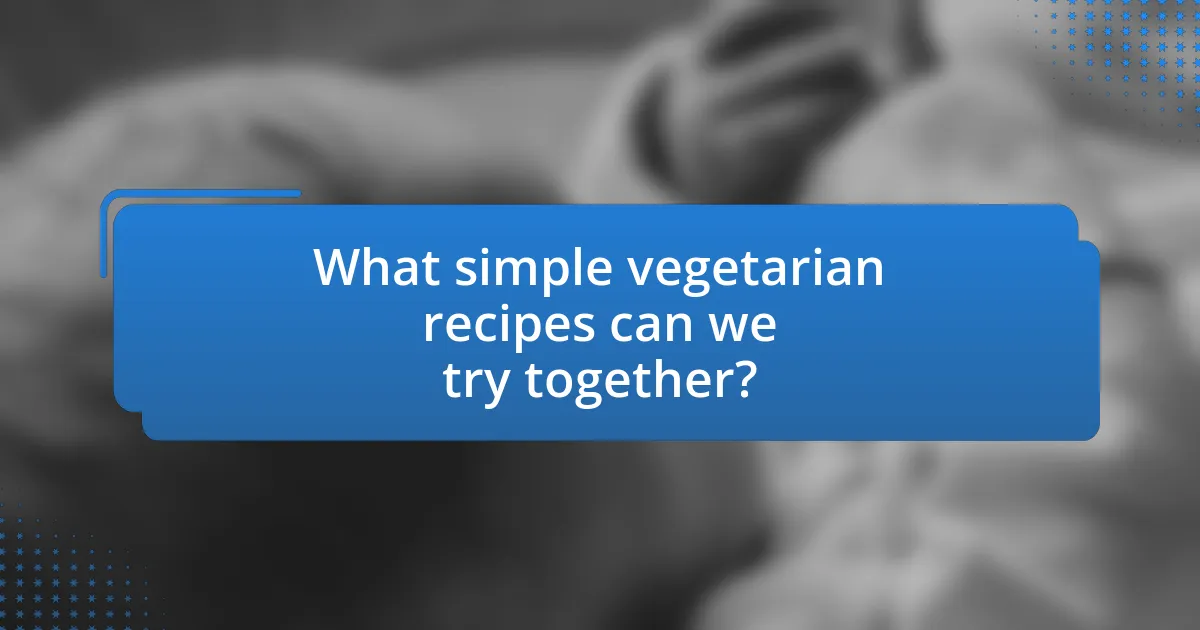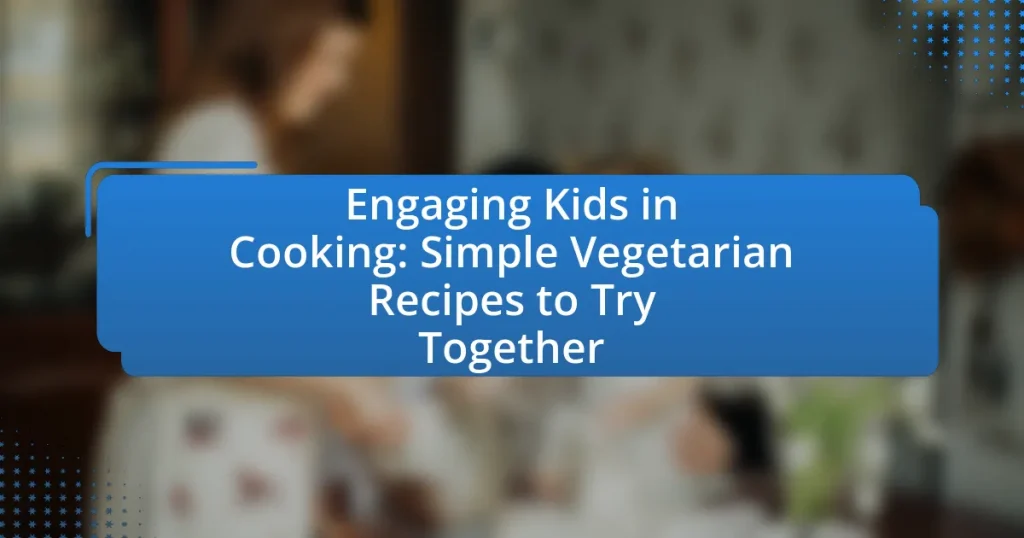Engaging kids in cooking is a valuable practice that enhances their culinary skills, promotes healthy eating habits, and fosters family bonding. This article explores the importance of involving children in meal preparation, highlighting the development of essential life skills such as teamwork, creativity, and food safety. It discusses the benefits of vegetarian cooking, including improved nutrition and environmental impact, while providing simple vegetarian recipes suitable for children. Additionally, the article addresses common challenges faced when cooking with kids and offers strategies to create a fun, educational, and safe cooking experience.

What is Engaging Kids in Cooking?
Engaging kids in cooking involves actively involving children in the preparation and cooking of meals, fostering their interest in food and nutrition. This practice not only enhances their culinary skills but also promotes creativity, teamwork, and a sense of accomplishment. Research indicates that children who participate in cooking activities are more likely to develop healthier eating habits and a greater appreciation for diverse foods, as evidenced by a study published in the Journal of Nutrition Education and Behavior, which found that cooking with children can increase their willingness to try new vegetables.
Why is it important to involve kids in cooking?
Involving kids in cooking is important because it fosters essential life skills and promotes healthy eating habits. Engaging children in the cooking process helps them develop skills such as measuring, following instructions, and understanding food safety. Research indicates that children who participate in cooking are more likely to try new foods and make healthier food choices, as evidenced by a study published in the Journal of Nutrition Education and Behavior, which found that cooking classes increased children’s willingness to eat fruits and vegetables. Additionally, cooking together can strengthen family bonds and improve communication, making it a valuable activity for both personal development and family dynamics.
How does cooking together enhance family bonding?
Cooking together enhances family bonding by fostering communication and collaboration among family members. When families engage in the cooking process, they share responsibilities, discuss meal preferences, and work towards a common goal, which strengthens their relationships. Research indicates that shared activities, such as cooking, can improve family cohesion and emotional connections. A study published in the Journal of Family Psychology found that families who cook together report higher levels of satisfaction in their relationships, highlighting the importance of shared experiences in building strong family ties.
What skills do children develop through cooking?
Children develop a variety of skills through cooking, including fine motor skills, math skills, reading comprehension, and teamwork. Fine motor skills are enhanced as children chop, stir, and measure ingredients, which improves their hand-eye coordination and dexterity. Math skills are developed through measuring ingredients and understanding proportions, which reinforces basic arithmetic concepts. Reading comprehension is improved as children follow recipes, learning to interpret instructions and expand their vocabulary. Additionally, cooking fosters teamwork and communication skills as children collaborate with others, learning to share tasks and responsibilities. These skills are supported by research indicating that hands-on cooking activities can significantly enhance cognitive and social development in children.
What are the benefits of vegetarian cooking for kids?
Vegetarian cooking for kids offers numerous benefits, including improved nutrition, enhanced cooking skills, and increased awareness of healthy eating habits. A diet rich in fruits, vegetables, whole grains, and legumes provides essential vitamins, minerals, and fiber, which are crucial for children’s growth and development. Research indicates that children who consume plant-based diets tend to have lower risks of obesity, heart disease, and type 2 diabetes. Additionally, involving kids in vegetarian cooking fosters their culinary skills, encouraging creativity and independence in the kitchen. This hands-on experience also promotes a greater understanding of food sources and sustainability, helping children make informed dietary choices as they grow.
How does a vegetarian diet contribute to health?
A vegetarian diet contributes to health by promoting lower risks of chronic diseases, improving heart health, and supporting weight management. Research indicates that individuals following a vegetarian diet often have lower blood pressure, cholesterol levels, and body mass index (BMI), which are all factors associated with reduced risk of heart disease and diabetes. A study published in the Journal of the American Heart Association found that vegetarian diets are linked to a 32% lower risk of heart disease compared to non-vegetarian diets. Additionally, vegetarian diets are typically rich in fruits, vegetables, whole grains, and legumes, providing essential nutrients and antioxidants that enhance overall health and well-being.
What environmental benefits come from cooking vegetarian meals?
Cooking vegetarian meals significantly reduces environmental impact by lowering greenhouse gas emissions, conserving water, and preserving biodiversity. Research indicates that plant-based diets can reduce carbon footprints by up to 50% compared to meat-based diets, as livestock farming is a major contributor to methane emissions and deforestation. Additionally, producing vegetables typically requires less water; for instance, it takes about 1,800 gallons of water to produce one pound of beef, while only 39 gallons are needed for a pound of vegetables. This shift towards vegetarian cooking not only mitigates climate change but also helps protect ecosystems by reducing the demand for land used for animal agriculture, thus preserving habitats for various species.

What simple vegetarian recipes can we try together?
Simple vegetarian recipes to try together include vegetable stir-fry, caprese salad, and veggie tacos. Vegetable stir-fry can be made by sautéing a mix of bell peppers, broccoli, and carrots in olive oil, seasoned with soy sauce and garlic. Caprese salad consists of fresh mozzarella, tomatoes, and basil drizzled with balsamic vinegar, providing a refreshing dish. Veggie tacos can be prepared using black beans, corn, diced tomatoes, and avocado, all wrapped in corn tortillas. These recipes are straightforward, requiring minimal cooking skills, making them ideal for engaging kids in cooking.
What are some easy vegetarian recipes suitable for kids?
Easy vegetarian recipes suitable for kids include vegetable quesadillas, mini veggie pizzas, and fruit and yogurt parfaits. Vegetable quesadillas can be made by filling tortillas with cheese and assorted vegetables like bell peppers and spinach, then grilling until crispy. Mini veggie pizzas involve using whole grain English muffins topped with tomato sauce, cheese, and various vegetables, baked until the cheese melts. Fruit and yogurt parfaits consist of layering yogurt with fresh fruits and granola, making a nutritious and visually appealing snack. These recipes are not only simple to prepare but also encourage kids to engage in cooking while enjoying healthy ingredients.
How can we make vegetable stir-fry fun and engaging?
To make vegetable stir-fry fun and engaging, involve kids in the cooking process by allowing them to choose their favorite vegetables and colors. This participation fosters excitement and ownership over the meal. Research indicates that children are more likely to try foods they have helped prepare, enhancing their willingness to eat vegetables. Additionally, incorporating interactive elements, such as using colorful utensils or creating fun shapes with the vegetables, can further engage kids. Engaging them in discussions about the nutritional benefits of each vegetable can also make the experience educational and enjoyable.
What ingredients are needed for a simple veggie pizza?
A simple veggie pizza requires a pizza crust, tomato sauce, shredded mozzarella cheese, and a variety of vegetables such as bell peppers, onions, mushrooms, and spinach. The pizza crust serves as the base, while the tomato sauce adds flavor and moisture. Shredded mozzarella cheese provides a creamy texture and binds the toppings together. The selection of vegetables not only enhances the taste but also adds nutritional value, making the pizza a healthy option.
How can we adapt recipes to suit different age groups?
To adapt recipes to suit different age groups, modify ingredients, cooking techniques, and portion sizes based on the developmental needs and preferences of each group. For example, for toddlers, use softer textures and smaller pieces to prevent choking, while for older children, incorporate more complex flavors and allow them to participate in meal preparation to enhance their cooking skills. Research indicates that involving children in cooking can improve their willingness to try new foods and develop healthy eating habits (Harris et al., 2018, Journal of Nutrition Education and Behavior).
What tasks can younger kids safely handle in the kitchen?
Younger kids can safely handle tasks such as washing vegetables, stirring ingredients, and assembling simple dishes. These activities allow children to participate in cooking while minimizing risks associated with sharp tools or hot surfaces. For example, washing vegetables helps develop their understanding of food preparation, while stirring ingredients fosters motor skills and coordination. Engaging in these tasks not only promotes safety but also encourages a sense of accomplishment and interest in cooking.
How can older kids take on more complex cooking responsibilities?
Older kids can take on more complex cooking responsibilities by gradually increasing their involvement in meal preparation and introducing them to advanced techniques. For instance, they can start by mastering basic knife skills and understanding cooking terminology, which lays the foundation for more intricate tasks. As they gain confidence, they can be assigned to prepare entire dishes, manage cooking times, and experiment with flavors, allowing them to develop creativity and problem-solving skills in the kitchen. Research indicates that children who engage in cooking activities show improved self-efficacy and a greater willingness to try new foods, which supports their overall development and independence in culinary tasks.

How can we make cooking a fun and educational experience?
Cooking can be made a fun and educational experience by involving children in hands-on activities that teach them about nutrition, food preparation, and cultural diversity. Engaging kids in cooking allows them to learn essential life skills, such as measuring ingredients, following recipes, and understanding cooking techniques. Research shows that children who participate in cooking activities are more likely to develop healthier eating habits and a greater appreciation for food. For example, a study published in the Journal of Nutrition Education and Behavior found that children who engaged in cooking classes showed increased fruit and vegetable consumption. By incorporating simple vegetarian recipes, parents can create an enjoyable environment that fosters learning and creativity in the kitchen.
What tips can help keep kids engaged while cooking?
To keep kids engaged while cooking, involve them in age-appropriate tasks that match their skill levels. Assigning specific roles, such as measuring ingredients, stirring, or decorating dishes, allows children to feel a sense of ownership and accomplishment. Research indicates that hands-on activities enhance learning and retention, making cooking a valuable educational experience. Additionally, incorporating fun elements, like themed cooking days or allowing kids to choose recipes, can further increase their interest and excitement in the kitchen.
How can we incorporate learning moments into cooking sessions?
Incorporating learning moments into cooking sessions can be achieved by integrating educational discussions about ingredients, cooking techniques, and nutrition. For instance, while preparing a dish, parents can explain the nutritional benefits of vegetables used, such as how carrots are high in beta-carotene, which is good for vision. Additionally, teaching kids about measuring ingredients can enhance their math skills, as they learn to use cups and spoons accurately. Research shows that hands-on cooking experiences can improve children’s understanding of healthy eating and food preparation, making the cooking session both enjoyable and educational.
What games or activities can we include during cooking time?
During cooking time, you can include games such as ingredient scavenger hunts, where children search for specific items in the kitchen, and cooking-themed charades, where they act out cooking actions. These activities enhance engagement and learning, making the cooking experience enjoyable. Research indicates that interactive activities in cooking can improve children’s understanding of food and nutrition, fostering a positive attitude towards healthy eating.
What are some common challenges when cooking with kids?
Common challenges when cooking with kids include safety concerns, limited attention spans, and varying skill levels. Safety concerns arise from the use of sharp utensils and hot surfaces, which can pose risks to children. Limited attention spans can lead to distractions, making it difficult to complete tasks efficiently. Additionally, varying skill levels among children can result in frustration, as some may struggle with basic cooking techniques while others may find them too easy. These challenges can hinder the cooking experience, but they can also provide opportunities for teaching and bonding.
How can we handle messes and distractions in the kitchen?
To handle messes and distractions in the kitchen, establish a structured cooking environment by designating specific areas for food preparation and clean-up. This organization minimizes clutter and helps maintain focus. For instance, using separate cutting boards for vegetables and proteins can prevent cross-contamination and reduce mess. Additionally, involving children in the cooking process can keep them engaged and focused, thereby reducing distractions. Research indicates that children who participate in cooking activities are more likely to develop healthy eating habits and stay attentive during the process.
What strategies can help manage picky eaters during cooking?
To manage picky eaters during cooking, involve them in the meal preparation process. Engaging children in cooking can increase their willingness to try new foods, as studies show that participation in food-related activities enhances their acceptance of various ingredients. Allowing kids to choose recipes, select ingredients, and assist in cooking fosters a sense of ownership and curiosity about the food, which can lead to more adventurous eating habits. Additionally, presenting food in fun and creative ways, such as using colorful vegetables or arranging food into shapes, can make meals more appealing to picky eaters.
What are the best practices for a successful cooking experience?
The best practices for a successful cooking experience include preparation, organization, and engagement. Preparation involves gathering all ingredients and tools before starting, which minimizes distractions and enhances focus. Organization means setting up a clean workspace and following a structured recipe, ensuring that each step is clear and manageable. Engagement, particularly when cooking with kids, fosters a fun atmosphere; involving them in age-appropriate tasks boosts their confidence and interest in cooking. Research indicates that children who participate in cooking activities are more likely to try new foods and develop healthier eating habits.
How can we prepare the kitchen and ingredients beforehand?
To prepare the kitchen and ingredients beforehand, start by organizing the workspace and gathering all necessary tools and ingredients. This includes cleaning countertops, ensuring utensils and cookware are readily available, and measuring out ingredients in advance. Research indicates that a well-organized kitchen enhances efficiency and reduces stress during cooking, making it easier for kids to engage in the process. Having everything prepped allows for a smoother cooking experience, fostering a positive environment for learning and collaboration.
What safety measures should we take when cooking with kids?
When cooking with kids, it is essential to implement safety measures such as supervising them at all times, using age-appropriate tools, and teaching them about kitchen hazards. Supervision ensures that children do not engage in unsafe behaviors, while age-appropriate tools, like plastic knives for younger children, minimize the risk of injury. Additionally, educating kids about hazards, such as hot surfaces and sharp objects, fosters awareness and caution in the kitchen. According to the American Academy of Pediatrics, involving children in cooking can enhance their understanding of food safety and nutrition, making these measures crucial for a safe cooking experience.


